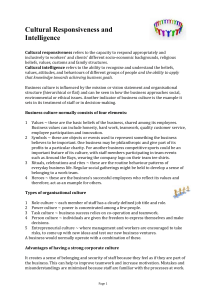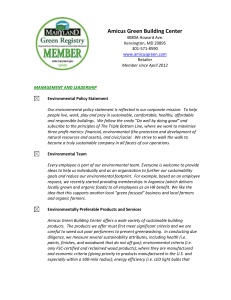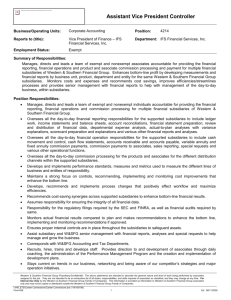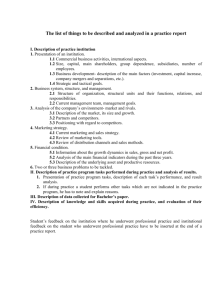Counsel of Record for Amicus Curić Martin J. Newhouse New
advertisement
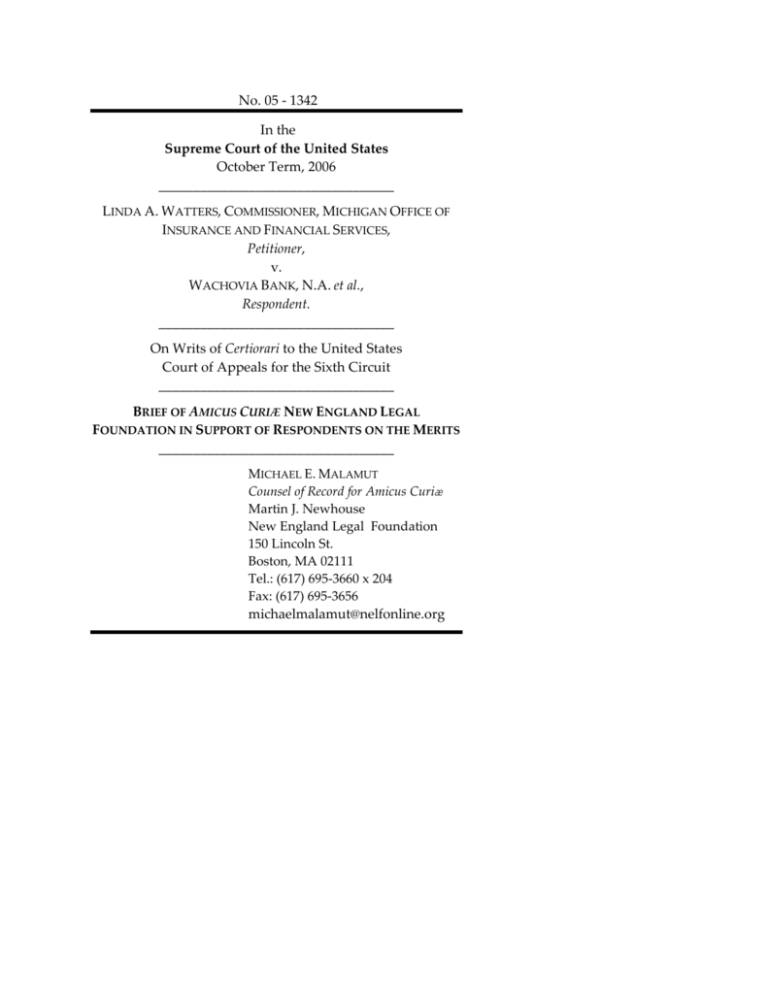
No. 05 - 1342 In the Supreme Court of the United States October Term, 2006 __________________________________ LINDA A. WATTERS, COMMISSIONER, MICHIGAN OFFICE OF INSURANCE AND FINANCIAL SERVICES, Petitioner, v. WACHOVIA BANK, N.A. et al., Respondent. __________________________________ On Writs of Certiorari to the United States Court of Appeals for the Sixth Circuit __________________________________ BRIEF OF AMICUS CURIÆ NEW ENGLAND LEGAL FOUNDATION IN SUPPORT OF RESPONDENTS ON THE MERITS __________________________________ MICHAEL E. MALAMUT Counsel of Record for Amicus Curiæ Martin J. Newhouse New England Legal Foundation 150 Lincoln St. Boston, MA 02111 Tel.: (617) 695-3660 x 204 Fax: (617) 695-3656 michaelmalamut@nelfonline.org QUESTIONS PRESENTED Amicus Curiæ New England Legal Foundation (“NELF”) adopts the Questions Presented as stated by Respondents Wachovia Bank, N.A. et al.: National banks’ “incidental powers” under the National Bank Act [defined at 12 U.S.C. § 38] include the power to conduct banking activities through operating subsidiaries that are licensed, regulated and supervised by the Office of the Comptroller of the Currency (“OCC”). National bank activities conducted through an operating subsidiary are subject to the “same terms and conditions” that apply to the conduct of such activities by the national bank. 12 U.S.C. § 24a; 12 C.F.R. § 5.34(e)(3). National banks’ federally-authorized mortgage lending activities are regulated and supervised exclusively by the OCC. The questions presented are: 1. Whether national bank mortgage lending activities are subject to exclusive OCC regulation and supervision when conducted through an operating subsidiary, just as they are when conducted directly by the parent bank. 2. Whether the OCC’s exclusive regulation and supervision of national bank mortgage lending activities conducted through operating subsidiaries is permissible under the Tenth Amendment. In this Brief, Amicus Curiæ New England Legal Foundation (“NELF”) principally addresses the first question as stated by Respondents. i ii TABLE OF CONTENTS QUESTION PRESENTED ................................................................... i TABLE OF CONTENTS ...................................................................iii TABLE OF AUTHORITIES ................................................................v INTEREST OF AMICUS CURIÆ ........................................................ 1 STATEMENT OF THE CASE ............................................................. 3 SUMMARY OF ARGUMENT ............................................................ 3 ARGUMENT .................................................................................... 4 I. Preemption of state regulation of national bank subsidiaries is reasonable and sound public policy because the inherent inefficiency of duplicative regulation outweighs any potential benefit ................................ 4 II. Only federal regulators, such as the OCC, can properly determine whether parallel state regulation of federally regulated national bank subsidiaries is warranted ................. 13 CONCLUSION ............................................................................... 16 iii iv TABLE OF AUTHORITIES Cases Bell v. Reno, 218 F.3d 86 (2d Cir. 2000) ...................................... 6 Chevron, USA, Inc. v. Natural Resources Defense Council, 467 U.S. 837 (1984) ........................................... 6 Lettman v. Reno, 207 F.3d 1368 (11th Cir. 2000) ........................ 6 M’Culloch v. Maryland, 17 U.S. (4 Wheat.) 316 (1819) ...... 13,14 Smiley v. Citibank (S.D.), N.A., 517 U.S. 735 (1996) ................ 15 Wachovia Bank, N.A. v. Burke, 319 F. Supp. 275 (D. Conn. 2004), aff’d, 414 F.3d 305 (2d Cir. 2005) ........................ 5 Wachovia Bank, N.A. v. Watters, 334 F. Supp. 2d 957 (W.D. Mich. 2004), aff’d, 431 F.3d 556 (6th Cir. 2005) ............ 5 Wachovia Bank, N.A. v. Watters, 431 F.3d 556 (6th Cir. 2005) .. 5 Constitution, Statutes, and Regulations U.S. Const. Art. VI .................................................................. 8,13 National Banking Act (“NBA”), defined at 12 U.S.C. § 38 ... 4,5 12 U.S.C. § 24a (g) (3) .................................................................. 5 12 U.S.C. § 484 (a) ........................................................................ 5 Pub. L. 106–102, Gramm-Leach-Bliley Act (“GLBA”) ......... 5,9 Pub. L. 104-290, National Securities Markets Improvement Act of 1996 ....................................................................... 7 12 C.F.R. § 7.4006 (“Section 7.4006”) ............................... 3,4,5,6 66 Fed. Reg. 34,784 (July 2, 2001) .............................. 5,6,9,10,13 61 Fed. Reg. 66,561 (Dec. 18, 1996) .......................................... 10 v Miscellaneous 145 Cong. Rec. H12,047 (Sept. 28, 1996) ................................... 7 Debate in North Carolina Ratifying Convention, July 29–30, 1788 (Statement of Mr. Davie), included in 4 Philip B. Kurland & Ralph Lerner, eds., The Founders’ Constitution, Article 6, Clause 2, No. 19, at 601 (1987) ...................................... 8 Small Business Administration, Office of Advocacy, Financing Patterns of Small Firms: Findings from the 1998 Survey of Small Business Finance (Sept. 2003), available at http://www.sba.gov/ADVO/stats/ ssbf_98.pdf .................................................................... 11 United States Environmental Protection Agency, Office of Air Quality Planning & Standards, Innovative Strategies and Economics Group, Economic Analysis Resource Document (April 1999), available at http://www.epa.gov/ttn/ecas/econdata/ Rmanual2/0.0.html ....................................................... 11 United States Office of Management & Budget, Circular A-4 (Sept. 17, 2003) (Regulatory Analysis), included in National Academies Press, Valuing Health for Regulatory Cost-Effectiveness Analysis (2006), at 258, available at http://fermat.nap.edu/books/ 0309100771/html/258.html ......................................... 7,9 Gabe de Bondt, Retail Bank Interest-Rate Pass-Through: New Evidence at the Euro Area Level, European Central Bank Working Paper Series No. 136 (April 2002), available at http://www.ecb.int/pub/pdf/scpwps/ ecbwp136.pdf ................................................................ 10 vi W. Mark Crain, Small Business Administration, Office of Advocacy, The Impact of Regulatory Costs on Small Firms (Sept. 2005), available at http://www.sba.gov/ advo/research/rs264tot.pdf ......................................... 11 C. Boyden Gray, Regulation and Federalism, 1 Yale J. on Reg. 93 (1983) ................................... 7,8,9,10 Boris Hoffmann & Paul Mizen, Interest Rate Pass-through and Monetary Transmission: Evidence from Individual Financial Institutions’ Retail Rates, 71 Economica 99 (2004) ................................................ 11 Raymond J. Keating, Small Business & Entrepreneurship Council, Small Business Survival Index 2006 (Oct. 2006), available at http://www.sbsc.org/Media/ pdf/SBSI_2006.pdf ........................................................ 12 James Madison, Federalist, No. 44 (Jan. 25, 1788) .................. 13 Charles Ou, Small Business Administration, Office of Advocacy, Working Paper, Statistical Databases for Economic Research on the Financing of Small Firms in the United States (2004), available at http://www.sba. gov/advo/research/wkp04Ou.pdf .............................. 11 Richard J. Pierce, Jr., Regulation, Deregulation, Federalism, and Administrative Law: Agency Power to Preempt State Regulation, 46 U. Pitt. L. Rev. 607 (1985) ................. 8,15 Note, Preemption and Regulatory Efficiency in Federal Energy Statutes, 103 Harv. L. Rev. 1306 (1990) ................... 7,10 vii viii No. 05 - 1342 In the Supreme Court of the United States October Term, 2006 __________________________________ LINDA A. WATTERS, COMMISSIONER, MICHIGAN OFFICE OF INSURANCE AND FINANCIAL SERVICES, Petitioner, v. WACHOVIA BANK, N.A. et al., Respondent. __________________________________ On Writs of Certiorari to the United States Court of Appeals for the Sixth Circuit __________________________________ BRIEF OF AMICUS CURIÆ NEW ENGLAND LEGAL FOUNDATION IN SUPPORT OF RESPONDENTS ON THE MERITS INTEREST OF AMICUS CURIÆ Amicus Curiæ New England Legal Foundation (“NELF”) seeks to bring to the Court’s attention its views, and the views of its supporters, concerning the authority of the Office of the Comptroller of the Currency (“OCC”) to preempt state regulation of national bank subsidiaries.1 1 Pursuant to Supreme Court Rule 37.6, counsel for Amicus states that neither counsel for Petitioners nor Respondent authored this Brief in whole or in part and no person or entity other than Amicus made a monetary contribution to the preparation or submission of the brief. Pursuant to Supreme Court Rule 37.3 (a), counsel for Amicus has submitted consent by Respondents to the filing of this Brief and that Petitioner’s consent to all amicus briefs is on file with this Court. Amicus Curiæ NELF is a non-profit, public interest law firm, incorporated in Massachusetts in 1977. It is headquartered in Boston. Its membership consists of corporations, law firms, individuals, and others who believe in NELF’s mission of promoting balanced economic growth for the United States and the New England region, protecting the free enterprise system, and defending economic rights. NELF’s more than 130 members and supporters include a cross-section of large and small corporations from all parts of New England and the United States. NELF’s members are affected by the business climate in New England, which depends, in part, upon fairly balanced and efficient business regulation with clearly determined reporting responsibilities. Many of NELF’s members are banks and many other NELF members are engaged in heavily regulated industries, such as insurance, healthcare, and energy production and distribution. Therefore, they are concerned about the proper balance of state and federal regulations in their industries. They are especially concerned about the impact of unnecessary costs associated with inefficient, uncoordinated, and duplicative regulations. Furthermore, some of NELF’s members, particularly those in the small business sector who often operate on the margins of profitability. are concerned with duplicative regulation because they utilize the services of regulated industries and must therefore bear the passed-on costs of such regulation. NELF has regularly appeared in state and federal courts, as party or counsel, in cases raising issues of general economic significance to the New England and national business communities. See, e.g., Rapanos v. United States, 126 S. Ct. 2208 (2006); S.D. Warren Co. v. Maine Bd. of Envtl. Protection, 2 126 S. Ct. 1843 (2006); Kelo v. City of New London, 545 U.S. 469 (2005); San Remo Hotel, L.P. v. City of San Francisco, 545 U.S. 323 (2005); Exxon Mobil Corp. v. Saudi Basic Indus. Corp., 125 S. Ct. 1517 (2005); Commissioner v. Banks, 125 S. Ct. 826 (2005); Green Tree Fin. Corp. v. Bazzle, 539 U.S. 444 (2003); EEOC v. Waffle House, Inc., 534 U.S. 279 (2002); Palazzolo v. Rhode Island, 533 U.S. 606 (2001); Crosby v. National Foreign Trade Council, 530 U.S. 363 (2000). NELF served as amicus curiæ in Wachovia Bank, N.A. v. Burke, 414 F.3d 305 (2d Cir. 2005), cert. pending, 05-431 (filed Sept. 30, 2005), which addressed similar issues to those raised in this case. A reversal by this Court of the decision of United States Court of Appeals for the Sixth Circuit below would result in duplicative state and federal regulation of national bank subsidiaries, resulting in significant additional costs to the banking sector, which could have an adverse effect on the business climate of New England and the nation as a whole. For these reasons, NELF’s members are concerned about the issues presented in this case. Amicus Curiæ therefore believes that this brief provides an additional perspective which may aid the Court in determining the issues raised in this case. STATEMENT OF THE CASE Amicus adopts the Statement of the Case contained in the Brief of Respondents. SUMMARY OF ARGUMENT This Amicus Brief focuses on the sound public policy reasons for enforcing the Office of the Comptroller of the Currency (“OCC”) regulation preempting duplicative state regulation of national bank subsidiaries. 12 C.F.R. § 7.4006 3 (“Section 7.4006”). Amicus argues that the regulation issued by OCC preempting state regulation of national bank subsidiaries was properly issued, because it is a reasonable interpretation of the relevant provisions of the National Banking Act, defined at 12 U.S.C. § 38 (“NBA”). Moreover, parallel regulation by state and federal governments of national banking subsidiaries would result in unnecessary, inefficient, and costly duplicative regulation. The costs of any such duplicative regulation would inevitably be passed on to the banks’ customers, resulting in higher interest rates and fees for borrowing. These additional costs are likely to have a particularly harmful effect on small businesses, many of which operate on the margins of profitability, and rely on financing through the type of home equity loans that are at issue in this case. Even relatively small cost increases attributable to duplicative regulation can have a serious adverse impact on a struggling small business. In the American federal system, OCC, as the federal regulator in charge of administering the NBA, must be allowed to determine to what extent parallel state regulation is consistent with the federal legislative scheme. The OCC has reasonably determined that parallel state regulation of national bank subsidiaries is unwarranted and should be preempted. This economically efficient determination should be upheld. ARGUMENT I. Preemption of state regulation of national bank subsidiaries is reasonable and sound public policy because the inherent inefficiency of duplicative regulation outweighs any potential benefit. This case involves the attempt by Petitioner, the Commissioner of the Michigan Office of Insurance and Financial Services (“Commissioner”), to regulate Respondent 4 Wachovia Mortgage Corp. (“Wachovia Mortgage”), a wholly owned operating subsidiary of Respondent national bank Wachovia Bank, N.A. (“Wachovia Bank”). (Collectively, Wachovia Mortgage and Wachovia Bank are referred to herein as “Wachovia.”) The OCC regulates national banks under the National Banking Act, defined at 12 U.S.C. § 38 (“NBA”). 12 U.S.C. § 484 (a) of the NBA preempts state regulatory oversight, called “visitation,” of national banks. On June 29, 2001, OCC issued 12 C.F.R. § 7.4006 (“Section 7.4006”), which permits state regulation of national bank subsidiaries only to the extent that states may regulate national banks themselves. 66 Fed. Reg. 34,784, 34,792 (July 2, 2001).2 Section 7.4006 states: “Unless otherwise provided by Federal law or OCC regulation, State laws apply to national bank operating subsidiaries to the same extent that those laws apply to the parent national bank.” The District Court and Court of Appeals agreed with Wachovia that Section 7.4006 preempts state regulation of national bank subsidiaries, such as Wachovia Mortgage. Wachovia Bank, N.A. v. Watters, 334 F. Supp. 2d 957 (W.D. Mich. 2004), aff’d, 431 F.3d 556 (6th Cir. 2005). In another recent case involving similar state regulations in Connecticut, the courts similarly upheld preemption under Section 7.4006. Wachovia Bank, N.A. v. Burke, 319 F. Supp. 275 (D. Conn. 2004), aff’d, 414 F.3d 305 (2d Cir. 2005). In her brief, the Commissioner futilely attempts to 2 The regulation was part of the OCC’s effort to conform its regulations to the Gramm-Leach-Bliley Act, Pub. L. 106–102 (“GLBA”). 66 Fed. Reg. at 34,784, 37,788. Relevant provisions of GLBA include the regulation of national bank subsidiaries that “are conducted subject to the same terms and conditions that govern the conduct of such activities by national banks.” 12 U.S.C. § 24a (g) (3). 5 avoid analysis of Section 7.4006 under the long-standing test for federal preemption prescribed by Chevron, USA, Inc. v. Natural Resources Defense Council, 467 U.S. 837 (1984). Commissioner’s Brief at 28–38. Chevron, however, mandates that courts, when interpreting a regulation to determine its preemptive effect on state law, examine whether the challenged regulation was “based on a permissible construction of the [applicable] statute,” in this case, the NBA. Chevron, 467 U.S. at 843. In that regard, courts should generally uphold the construction by the applicable agency when it is reasonable. See Bell v. Reno, 218 F.3d 86, 90 (2d Cir. 2000); Lettman v. Reno, 207 F.3d 1368, 1371–72 (11th Cir. 2000). Amicus contends that the reasonableness analysis under Chevron implicates the very public policy concerns that Amicus relies on in its argument. In this case, OCC thoughtfully considered the appropriateness of state regulation of national bank subsidiaries and reasonably determined that exclusive federal regulation made sense in the circumstances. 66 Fed. Reg. at 34,788–89.3 Amicus’s argument concentrates on the reasonableness of OCC’s intent to preempt state regulation of federal banking subsidiaries through Section 7.4006 and the sound public policy grounds for upholding the regulation.4 Although there 3 The OCC rulemaking by which it adopted Section 7.4006 discussed the comments on the proposed regulation (the majority of which supported the regulation). 66 Fed. Reg. at 34,788–89. OCC determined that criticisms of the proposed rule were ill-founded: “We disagree with those commentators who believe that the new § 7.4006 will adversely affect the oversight of operating subsidiaries either from a consumer protection or a safety and soundness perspective.” 66 Fed. Reg. at 34,789. 4 Amicus supports all the arguments made by Wachovia, but addresses primarily the public policy rationale supporting Section 7.4006, in 6 may be many areas of administrative law in which the federal government allows double regulation by both state and federal administrators, such duplicate regulation is often unduly complex, overly burdensome, and inherently prone to conflicting mandates. See 145 Cong. Rec. H12,047 (Sept. 28, 1996) (Conf. Rep. on HR3005, National Securities Markets Improvement Act of 1996, Pub. L. 104-290) (a “system of dual federal and state . . . regulation [may] result[] in a degree of duplicative and unnecessary regulation. . . . [A] dual system of regulation . . . , in many instances, is redundant, costly and ineffective.”); Note, Preemption and Regulatory Efficiency in Federal Energy Statutes, 103 Harv. L. Rev. 1306, 1308 (1990) (“[S]tate law that duplicates federal licensing should be preempted per se. At best duplication wastes regulatory effort, at worst, it subjects federal decisions to local review.”); United States Office of Management & Budget, Circular A-4 (Sept. 17, 2003) (Regulatory Analysis), contained in National Academies Press, Valuing Health for Regulatory Cost-Effectiveness Analysis (2006), at 258, 265, available at http://fermat.nap.edu/books/ 0309100771/html/258.html (stating that “duplicative regulations can also be costly. . . . The local benefits of State regulation may not justify the national costs of a fragmented regulatory system.”). Even though local control sometimes has benefits under certain circumstances, in many cases, such as the national banking industry, the countervailing need for a strong central government to facilitate interstate commerce warrants exclusive federal regulation. See C. Boyden Gray, Regulation regard to which Amicus believes it can be of greatest assistance to the Court by raising the concerns of its members with regard to duplicative regulation. 7 and Federalism, 1 Yale J. on Reg. 93, 95–96 (1983).5 Exclusive federal regulation of national banking subsidiaries is especially warranted because national banks are a significant part of the national monetary system, “with respect to which the appropriateness of a need for national-level [regulatory] activity is obvious.” Gray, 1 Yale J. on Reg. at 110.6 National banks are a major contributor to interstate commerce. The banking industry has undergone increasing consolidation in recent years, creating an increasingly nationwide industry. National bank subsidiaries are an integral part of the business of national banks, performing similar 5 Situations in which exclusive federal regulation is superior to local regulation include: (1) federal regulation [that] can prevent burdens on interstate commerce, (2) some socially beneficial programs [that] are easier to adopt as a political matter on a federal level, (3) [situations when] states may compete on the stringency of regulation to the detriment of the nation, and (4) [when] the federal government . . . has greater access to sources of the relatively scarce expertise essential to some types of regulatory programs. Richard J. Pierce, Jr., Regulation, Deregulation, Federalism, and Administrative Law: Agency Power to Preempt State Regulation, 46 U. Pitt. L. Rev. 607, 646 (1985). As discussed below, all of these rationales, with the possible exception of beneficial social programs, apply in the case of national banking subsidiaries. 6 One of the purposes of the Constitution’s Article Six Supremacy Clause was to allow the federal government to impose a national currency to supersede the numerous conflicting state paper money standards that had debased the value of money and stymied investment. See Debate in North Carolina Ratifying Convention, July 29–30, 1788 (Statement of Mr. Davie), included in 4 Philip B. Kurland & Ralph Lerner, eds., The Founders’ Constitution, Article 6, Clause 2, No. 19, at 601, 603 (1987). 8 operations to those that national banks could perform themselves, especially since the passage of the Gramm-LeachBliley Act, Pub. L. 106–102 (“GLBA”). See 66 Fed. Reg. at 34,788 (“Operating subsidiaries have often been described as the equivalent of departments or divisions of their parent banks.”). Banks service more and more mortgage customers through an increasingly nationwide financial market with mortgage interest rates determined by the national discount rate and long-term federal bond rates. Subsidiaries of national banks offer similar refinancing and equity line plans in numerous states, which similarly affect homeowners throughout the country. The alleged “predatory lending” schemes that concern the Commissioner, Commissioner’s Brief at 5, 24–25, are problems that “spill across state lines” and are generally best regulated at the federal level. See Office of Management & Budget, Circular A-4 (Regulatory Analysis), at 264. Thus, as for other industries of national scope, exclusive federal regulation of national banks and their operating subsidiaries makes sense because “[t]he wide differences in state laws, as well as the frequent changes in those laws, make it practically impossible for [such an industry] to determine the standards of conduct to which they will be held.” Gray, 1 Yale J. on Reg. at 97.7 In addition, banking provides similar services nationwide and requires considerable financial expertise to 7 “This uncertainty injures [national businesses] in a number of ways. Because [national businesses] cannot predict the standards by which their products will be judged, they may be reluctant to introduce . . . innovative products. Shifting and conflicting legal standards also generate extensive and expensive litigation, the costs of which are undoubtedly reflected in higher insurance rates.” Gray, 1 Yale J. on Reg. at 97. The parallel in this case would be higher interest rates in the secondary mortgage market primarily serviced by Wachovia Mortgage and other similar national bank subsidiaries. 9 regulate. Uniform federal regulation is warranted because of the efficiency of a single center for regulatory expertise, instead of fifty different state-based centers, many of which could not be adequately funded or would be located in areas without access to sophisticated academic or economic expertise. See Gray, 1 Yale J. on Reg. at 109; Note, 103 Harv. L. Rev. at 1308 (federal regulation can “attract experts from a limited pool [and] solidify uniform, nationwide policy.”). Another, perhaps more pragmatic reason for exclusive nationwide regulation of national banking subsidiaries is the provision of fair treatment to different federal financial institutions in order to create a level competitive playing field. For example, since 1996, federal savings and loan association (“thrift”) subsidiaries have received express preemption from state regulation. 66 Fed. Reg. at 34,789 & n.19; 61 Fed. Reg. 66,561, 66,563 (Dec. 18, 1996). Parallel treatment of federal thrift subsidiaries and national bank subsidiaries, exempting both from state regulation, is clearly desirable. Otherwise thrifts would receive unfair and unintended competitive advantages through their exemption from costly duplicative state regulation. The Commissioner concedes that OCC has the right to regulate national bank subsidiaries, such as Wachovia Mortgage, so that if the Commissioner’s position prevailed, they would be subject to duplicative state and federal regulation. Commissioner’s Brief at 35–36. The costs incurred by such duplicative regulation inevitably will be passed on to the consumers of the bank’s loan services, both directly through higher interest rates and fees,8 and indirectly because 8 See, e.g., Gabe de Bondt, Retail Bank Interest-Rate Pass-Through: New Evidence at the Euro Area Level, European Central Bank Working Paper Series 10 the additional costs create a barrier to entry in the secondary loan market, decreasing competition. For the costs of the regulatory burden on small businesses, see W. Mark Crain, Small Business Administration, Office of Advocacy, The Impact of Regulatory Costs on Small Firms at 56 (Sept. 2005) (regulatory expenses rest disproportionately on small businesses), available at http://www.sba.gov/advo/research/rs264tot.pdf. These higher rates could well have a devastating impact on the small business sector, which is a major component of the economy in both Amicus’s focus region of New England and nationwide. The secondary mortgage market is a significant source of capital for small businesses. Small Business Administration, Office of Advocacy, Financing Patterns of Small Firms: Findings from the 1998 Survey of Small Business Finance at 12 & n.6 (Sept. 2003), available at http://www.sba.gov/ADVO/stats/ssbf_98.pdf; Charles Ou, Small Business Administration, Office of Advocacy, Working Paper, Statistical Databases for Economic Research on the Financing of Small Firms in the United States at 12 (2004), available at http://www.sba.gov/advo/research/ wkp04Ou.pdf. Many small businesses are sole proprietorships, small partnerships, or closely held corporations, who may not No. 136 (April 2002) (close to 100% long-term pass-through of changes in market interest rates to retail rates), available at http://www.ecb.int/pub/pdf/scpwps/ecbwp136.pdf; Boris Hoffmann & Paul Mizen, Interest Rate Pass-through and Monetary Transmission: Evidence from Individual Financial Institutions’ Retail Rates, 71 Economica 99 (2004) (high rates of long-term pass-through); United States Environmental Protection Agency, Office of Air Quality Planning & Standards, Innovative Strategies and Economics Group, Economic Analysis Resource Document § 5.1.3.2 (April 1999) (“[U]nder fairly general economic conditions, a regulation's impact on producers is transitory. Ultimately, the costs are passed on to consumers in the form of higher prices.”), available at http://www.epa.gov/ttn/ecas/ econdata/Rmanual2/0.0.html. 11 qualify for traditional business loans, or may not have the sophistication to apply for them. Instead, they turn to built up equity in their homes accessed through the secondary mortgage market to fund start-up costs and ongoing capital expenditures. Small businesses, although a significant sector of the business community and an engine of growth when taken as a whole, often operate on the margins of profitability, and small additional costs can make the difference between staying afloat and dissolution. Small businesses in New England (Amicus’s primary focus area), in particular, are vulnerable to regulatory costs and difficulties in obtaining financing. See Raymond J. Keating, Small Business & Entrepreneurship Council, Small Business Survival Index 2006 at 2, 5, 10–11, 15–16 (Oct. 2006), available at http://www.sbsc.org/Media/pdf/SBSI_2006.pdf (ranking Connecticut 32d, Vermont 42d, Massachusetts 43d, Maine 47th, and Rhode Island 48th, out of 50 states plus the District of Columbia). The additional interest costs attributable to coping with duplicative and possibly conflicting state and federal regulations over national bank subsidiaries providing home equity loans could make or break small businesses nationwide, and especially in New England where they already face higher than average burdens. OCC therefore reasonably determined, consistent with sound public policy, that uniform federal regulation of the national bank subsidiaries outweighs any benefits of local regulation. Exclusive federal regulation of national banking subsidiaries is manifestly warranted because, among other reasons, (1) they operate as an essential part of the national monetary system, (2) they are heavily involved in interstate commerce, (3) the expertise required to regulate them involves 12 complex financial analysis best obtained in a centralized federal setting, (4) duplicative regulation incurs passedthrough costs that harm consumers of secondary mortgages, in particular small businesses, and (5) fairness warrants similar federal regulatory treatment for federal thrift subsidiaries and national bank subsidiaries. II. Only federal regulators, such as the OCC, can properly determine whether parallel state regulation of federally regulated national bank subsidiaries is warranted. The Supremacy Clause contained in Article Six of the Constitution is an integral part of the system of checks and balances inherent in the American federal system. For the American federal system to work, the federal government must be the ultimate decision maker as to the proper balance between state and federal regulations. “The nation, on those subjects on which it can act, must necessarily bind its component parts.” M’Culloch v. Maryland, 17 U.S. (4 Wheat.) 316, 405 (1819).9 The first great case enforcing the Supremacy Clause of Article Six of the Constitution was a banking case, M’Culloch v. Maryland, which protected branches of the federal bank (the nineteenth century equivalent in many ways of national bank subsidiaries today)10 from state taxation. National banking has thus been a subject for the federal 9 If the states were allowed supremacy over the federal government, “the world would have seen . . . the authority of the whole society every where [sic] subordinate to the authority of the parts; it would have seen a monster in which the head was under the direction of the members.” James Madison, Federalist, No. 44 (Jan. 25, 1788). 10 National bank subsidiaries are analogous to departments or divisions of their parent banks. 66 Fed. Reg. at 34,788. 13 government from the foundation of the first Bank of the United States at the beginning of the Republic. Id. at 401–02. M’Culloch remains the bedrock of Supremacy Clause jurisprudence and its wisdom is as pertinent today as it was almost two hundred years ago. The Supreme Court held there that “the states have no power, by taxation or otherwise, to retard, impede, burden, or in any manner control, the operations of the constitutional laws enacted by congress to carry into execution the powers vested in the general government.” M’Culloch, 17 U.S. at 435–36 (emphasis added). While M’Culloch involved a state attempt to tax a branch of the national bank, the Supreme Court’s discussion of the coercive power of state taxation of federal entities, particularly banks, holds equally true for state regulation of those entities: That the power of taxation is one of vital importance, that it is retained by the states, that it is not abridged by the grant of a similar power to the Union, that it is to be concurrently exercised by the two governments—are truths which have never been denied. . . . [T]he . . . paramount [federal] character would seem to restrain . . . , a state from such other exercise of this power, as is in its nature incompatible with, and repugnant to, the constitutional laws of the Union. M’Culloch, 17 U.S. at 425. Therefore, just as “the power of taxing [the national bank] by the states may be exercised so as to destroy it,” M’Culloch, 17 U.S. at 427, the power of regulating the national banks and their subsidiaries by the states may be exercised so as to destroy them. 14 Federal regulatory agencies have several characteristics “that make them well suited to the task of allocating regulatory responsibility between themselves and state agencies [even] when Congress has not explicitly allocated that responsibility by statute.” Richard J. Pierce, Jr., Regulation, Deregulation, Federalism, and Administrative Law: Agency Power to Preempt State Regulation, 46 U. Pitt. L. Rev. 607, 664 (1985). This is particularly true when an industry is national in scope, such as banking, because state-by-state regulation can “create substantial, disproportionate interstate spillovers.” Id. Indeed, OCC’s interpretations of the NBA are entitled to great weight. See Smiley v. Citibank (S.D.), N.A., 517 U.S. 735, 739 (1996). A rationale federal system requires occasional federal preemption of state attempts to regulate national industries and only the federal government is able to make those decisions without engendering chaos in the federal order. Federal regulators, such as OCC, have the expertise to make decisions as to the proper balance between state and federal regulation of national bank subsidiaries. OCC thoroughly considered the issues and determined that preemption of state regulation was warranted. Its decision was eminently reasonable. This Court should enforce it. 15 CONCLUSION For the reasons stated above, this Court should affirm the decisions of the Court of Appeals for the Sixth Circuit below. Respectfully submitted, NEW ENGLAND LEGAL FOUNDATION, By its attorneys, Dated: November 3, 2006 Michael E. Malamut Counsel of Record for Amicus Curiæ Martin J. Newhouse New England Legal Foundation 150 Lincoln Street Boston, MA 02111-2504 Telephone: (617) 695-3660 x 204 Facsimile: (617) 695-3656 michaelmalamut@nelfonline.org 16
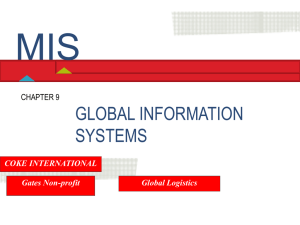

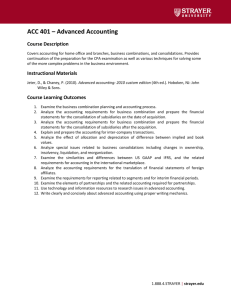

![[DOCX 51.43KB]](http://s3.studylib.net/store/data/007172908_1-9fbe7e9e1240b01879b0c095d6b49d99-300x300.png)
